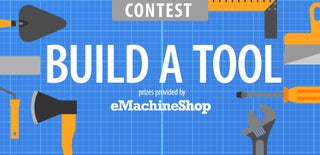Introduction: A Simple Workbench
This is my first workbench! I originally documented the build with this video, but decided to make an Instructable as well.
It cost me ~$80 for all the raw materials, including cutting, at Home Depot. The casters themselves were ~$40, so a cheaper source (NOT Home Depot) could bring the cost down significantly.
Step 1: Materials
Here is my materials and tools list:
Raw Materials:
- (4x) 4x4, 33"
- (4x) 2x4, 24"
- (2x) 24"x48" MDF
- (2x) 1/2" diameter dowel
- (4x) Locking casters, 3" wheel diameter
Tools Used:
- Drill
- Impact driver
- 1/2" Forstner bit (stopped cutting halfway through, so I used a drill bit instead)
- 1/2" drill bit
- 5/32" drill bit (clearance holes)
- 2.5" general purpose screws
- Wood glue
- Speed square (or anything that's square)
You can do a lot with very little - a drill and drill bits are the bare necessities.
Step 2: Strength and Rigidity
Oftentimes, tables will have a diagonal piece (as pictured in the first image, from woodgears.ca) for extra strength and rigidity. It provides lateral support to the legs and prevents them from buckling or moving when you're pushing on the table from the side.
This design, which I first saw in Matthias Wandel's workbench video, instead uses dowels inserted into both pieces in a joint (last two pictures). The dowels take all the forces that the diagonal brace takes, eliminating the need to add that brace. I liked this method because it frees up storage space and leg space, looks cleaner, and is cool as hell.
Step 3: The Legs
The legs of the workbench will be completed in two parts - left side, and right side.
The vertical portions of the legs are the 4x4 pieces, and the horizontal portions are the shorter 2x4 pieces. I left 1.5" of the 2x4 sticking out on either end, so the longer crossmembers (next step) will sit flush. I also messed up and left 1.5" sticking out on the bottom of the legs, which isn't necessary (as I don't have bottom crossmembers) but doesn't bother me because I can use that extra space to mount more storage solutions later on.
Assembly:
I started out by laying the legs out in the general position I needed them in - flush to the top and bottom, and 1.5" of the 2x4 sticking out on either end.
I drilled a clearance hole into the 2x4, which provides clearance for the threads of the screw to fit inside, and gives me a starting point for the screw to drill into the 4x4.
Once each leg was screwed into place, you'll notice that the rectangle can be deformed into a parallelogram. To remedy this, measure the two diagonals of the rectangle, and bang on one side or the other until the diagonals are equal.
I then used the Forstner bit to drill holes into both pieces, about 2" deep - 2 holes for each joint. I slathered the hole and a 2" long piece of dowel with wood glue, and inserted the dowel into the hole.
Step 4: Attaching the Crossmembers (Aprons)
The crossmembers of the workbench consist of the two long pieces of 2x4.
Assembly:
I laid the legs on their sides, using some scrap pieces of 2x4 for stability, and put the crossmembers in place. Since my legs had the extra 1.5" sticking out, my crossmembers could sit flush to the legs, and made squaring the whole bench easier.
Same process: drill, screw, drill, pound dowels in.
Make sure there's plenty of glue on the dowel and inside the hole - I used the shank of my small drill bit to apply the glue inside the hole more uniformly. When glue gets everywhere on the outside, rubbing sawdust on it cleans it up well.
This is about the time my Forstner bit stopped cutting well, so I switched to a drill bit.
Step 5: The Top
I wanted this workbench to be very sturdy, so I opted to use two pieces of MDF, layered on top of each other, as the top surface.
Assembly:
This part is pretty simple: glue the two pieces of MDF together, using plenty of glue and something heavy to "clamp" the two pieces together overnight. Then use the same drill/screw process to attach the top to the 2x4 pieces.
Also, use more glue than I did. Use LOTS of glue. WAY MORE THAN YOU THINK YOU NEED.
Step 6: Casters (Optional)
I wanted locking casters on the workbench so I could move it wherever I wanted, and lock it into place when I wanted to use it. The 33" of 4x4 accounts for a 3" caster, so if a caster is not needed, add maybe 4" of length to the 4x4 pieces.
Assembly:
Generally, when you're assembly wood with screws, you need to add both a pilot hole and a clearance hole. I didn't.
I just held the casters in place and drove screws into the appropriate holes. I'm an engineer - I get paid to be lazy. Or "efficient", depending on how you look at it.
Step 7: Last Notes
This isn't a machinist's workbench, where the surface is flat within 2 microns and the grain of the wood doubles as a measurement grid.
This is a beginner's workbench - my first try and first time working with wood in over a year. It's good enough for my purposes, and seems like it will hold up to my supernatural abuse powers.
Maybe don't mess up like I did and leave the extra 1.5" sticking out on the bottom. Or do it, it's whatever.
Definitely do try making this though! Unless you're a garage sale god and can find a sturdy workbench for cheaper. I sure couldn't.

Participated in the
Build a Tool Contest 2017

Participated in the
Woodworking Contest 2017













